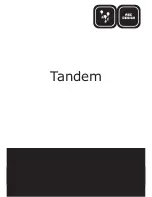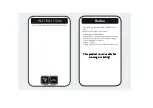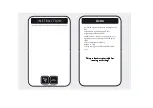
OPTIONAL FEATURES
HeatNet Control V3
Page 58
The system flow proving switch is implemented using
SPARE 3/System Water Flow on J11A. If a flow switch is
connected to the WTR FLW interlock, the HeatNet control
will wait up to 10 seconds to prove flow. If flow is
interrupted after it has been established, an error will be
displayed and the boiler will cycle OFF. As long as there is a
call for heat, every 10 minutes the circulator pump will try to
re-establish flow and start the boiler again.
When (2) system pumps are present and flow is not
established or is lost (2) things will occur to try and keep heat
in the system.
1.
When first starting a system:
If after a 10 second
wait to establish flow has failed, the first pump will
change to the second pump. The second pump will
now try to establish flow for 10 more seconds. If the
second pump fails to establish flow, the HeatNet
control waits
10 minutes
. After the 10 minutes has
expired, the control now starts with the second pump
and attempts to prove flow for 10 more seconds. If
flow does not prove, the control changes to the first
pump and attempts to prove flow. This cycle will
continue indefinitely until flow is established.
If flow
is lost while running:
this process is also used in an
attempt to re-establish flow.
2.
If PUMP ROTATION is set to PMP HRS the PUMP
ROTATION will be temporarily set to SYS HRS. This
is to prevent re-starting the failed pump due to its
runtime hours. Setting the PUMP ROTATION to SYS
HRS will allow a retry of the failed pump after the
rotation hours has expired. Power cycling of the boiler
or using the PUMP ROTATION menu will revert
back to PUMP ROTATION = PMP HRS if this was
the original setting.
For
system pump modulation
a 0-10Vdc control signal
output is provided at J4.3 (signal) and J4.7 (ground). This
signal is output by the Master boiler as a percent function of
the number of boilers running and can be used to set the
speed of a System Pump using a Variable Frequency Drive.
Two wires are required and need to be inserted into the J4.3
and J4.7 positions to access this signal.
This signal has a step response and is not linear
to the system or boiler’s input firing rate.
The output signal is proportionally mapped to % using the
equation:
%VFD = (boilers running/total boilers)
The %VFD represents the stepped percentage of boilers
running where:
0Vdc = 0% (to) 10Vdc = 100%
If there are (6) boilers in a system and (2) are running, the
control signal = 33% or 3.3Vdc. This signal could then be
applied to a system pump’s VFD to control the speed of the
pump relative to how many boilers are firing. The VFD
would need to be set appropriately to allow the correct flow
through each boiler.
In low volume systems sudden temperature changes may
occur when the flow is stepped up or down by a large
percentage. In these situations the ADAPTIVE MOD may
need to be disabled and the ORIGINAL KN method used.
Other adjustments may also be required.
Currently, no failsafe mode is available in the event the
Master boiler’s control fails. If this method is employed, a
failsafe boiler could be used to override the control signal
and enable the system pump’s VFD using some external
wiring and an external relay, or have the VFD default to a
safe speed on loss of the control signal.
If (2) pumps are available (Full, not Lite version), pump
rotation is available. The rotation of the (2) pumps can be
controlled using two methods.
3.
Pumps are switched based on the system run time
4.
Pumps are switched by the difference between each
pump’s runtime. The HeatNet control keeps a
running record of each pump’s runtime in hours. If
a pump is taken offline or replaced. The runtimes
can then be adjusted until they become equal.
These features may be selected in the menu,
SETUP: PUMP
OPTIONS: SYSTEM PUMP: PUMP ROTATION
The
local circulator pump
is supported by (3) modes and
(2) features.
1.
The first mode allows the circulator pump to remain on,
unless the control’s outside high air temperature setting
has been met when using Warm Weather Shutdown.
2.
The second mode will allow the circulator pump to be
turned on whenever there is a call for heat (any control
input). This mode will stop the circulator pump when the
call for heat is lost and the pump post purge time has
been satisfied.
3.
The third mode works much the same as mode 2, but it
allows the inlet sensor (RETURN) to be used with the
outlet sensor (SUPPLY) to keep the pump on until a
delta (difference) temperature is met. A return
temperature sensor is required for this mode, because the
delta temperature (SUPPLY – RETURN) measured is
across the boiler. In this mode, the post purge time is
also used. After the delta temp has been met, the post
purge time needs to expire before the pump is turned off.
This mode works much the same as mode 2.
Summary of Contents for FUTERA XLF Series
Page 27: ...CONTROL METHODS HeatNet Control V3 Page 27 Figure 25 Base loading relay...
Page 67: ...WIRING CONNECTIONS HeatNet Control V3 Page 67 Figure 49 Jumper Dip Switch Locations...
Page 73: ...WIRING CONNECTIONS HeatNet Control V3 Page 73 Figure 57 Temperature sensors...
















































